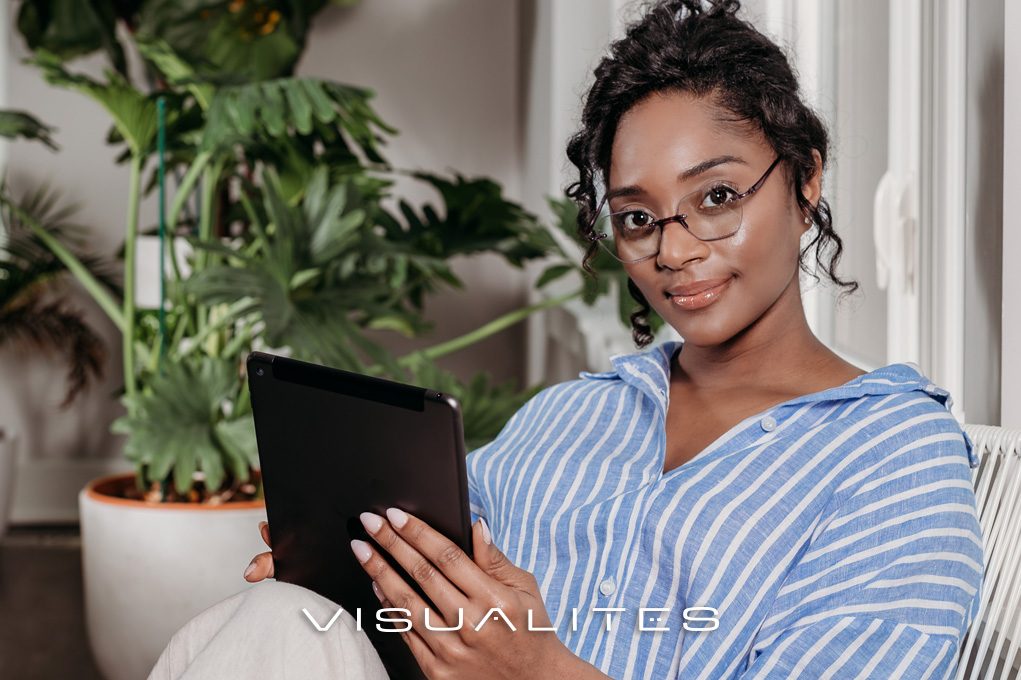
Computer Reading Glasses: The Solution to Blue Light
These Aren’t Your Mother’s Reading Glasses
The devices many of us use every day (smartphones, laptops, tablets, etc.) emit significant amounts of blue light, an unfocused visual “noise” reduces contrast that can contribute to digital eyestrain (Source National Library Of Medicine) and potentially eventual blindness. In other words, the gadgets we use regularly, like smartphones and laptops, give off a lot of blue light. This light messes with our eyes and can make them tired and strained. It can also lead to vision problems, including the risk of going blind in the long run. High energy blue light scatters more easily than other visible light and is not easily focused.
About Computer Reading Glasses and Plano Glasses
Blue light glasses, or computer reading glasses, are eyewear featuring a patented, advanced lens technology that helps reduce potentially harmful blue light from reaching your eyes.
Specially designed reading glasses for computer use reduce screen glare for less eye strain and improved contrast for a more comfortable digital experience. If you experience blurred vision, or your eyes feel strained, irritated, or dry when viewing screens (or if you are wanting to avoid these symptoms), computer reading glasses could be for you. There are no current standards for blue light blocking glasses and you want to make sure yours are doing the job. A simple home test goes as follow,when looking through the lenses towards a clear blue sky, you can more easily see this light being filtered away by the lenses and you will also see a slight yellow tint in the lenses. At Visualites our computer glasses block approximately 55% of the 400-440nm range of Blue Light, this is the range that has the most impact on your sleep and your eyes (Source National Library of Medicine).
Impacts Of Blue Light On The Eye
The fact that blue light penetrates all the way to the *retina (the inner lining of the back of the eye) is a distinguishing factor in the way blue light affects the eye compared to other types of light rays. Laboratory studies have shown that excessive exposure to blue light can damage light-sensitive cells in the retina that can cause damage to the retina similar to **macular degeneration, which is known to cause lack of vision.

Blue light itself is not necessarily a bad thing. In fact, it comes from the sun and is everywhere. Researchers have determined that ***blue wavelengths, the wavelengths at high ends of the light spectrum, are beneficial during daylight hours because they boost attention, reaction times, and mood. But with all this computer usage, blue light is being regularly beamed directly into our eyes. This is a significantly different dose of blue light than the human retina is suited to take on.
Blue Light Exposure & Sleep
Blue light exposure, particularly in the evening or nighttime, can disrupt sleep patterns and affect the quality of sleep in the following ways: melatonin suppression, circadian rhythm disruption. To mitigate the impact of blue light on sleep, individuals can take measures such as reducing screen time before bedtime, using blue light filters glasses (Source Harvard Business Review) or “night mode” settings on devices, and making their sleep environment more conducive to rest. Additionally, it’s essential to establish a regular sleep schedule and engage in relaxing bedtime rituals to promote healthy sleep patterns.
Direct, sustained exposure to artificial blue light can cause the following symptoms: headaches, blurred and/or double vision, eye fatigue, eye strain, dry, irritated, itchy eyes, and even neck, back, and shoulder pain due to changes in posture. Device users may experience digital eye strain symptoms differently. Some may feel most of the symptoms described; others may feel only one. Some people are more prone to Computer Vision Syndrome (Source: American Optometric Association) and Digital Eye Strain than others and everyone experiences it in varying degrees.
Protect Your Eyes & Sleep With Computer Reading Glasses
If you have been experiencing eye strain or any of the other symptoms described, we encourage you to investigate if blue light exposure could be part of the problem. Here at Visualites, we provide a wide selection of only the best computer reading glasses for you to choose from.
If you are ready to combat eye fatigue and the impact on your sleep that results from living in a new digital age we recommend trying one of our blue light filtering glasses that are appropriate for your age an vision.
Visualites C: Blue Light Blocking Reading Glasses in a full range of powers up to 3.50
Visualites G: Blue Light Blocking Gaming Glasses with no magnification or a slight magnification in the 0.50 or 0.75 power
Visualites P: Blue Light Blocking Glasses without magnification, made for younger wearers who do not need vision correction.
Definitions
* The retina is a light-sensitive layer of tissue located at the back of the eye. It plays a crucial role in the visual process by capturing and processing light signals. The retina contains specialized cells, including photoreceptors called rods and cones, which convert light into electrical signals. These signals are then transmitted to the brain through the optic nerve, where they are interpreted as images. The retina is essential for vision, as it allows us to perceive and interpret our surroundings.
** Macular degeneration, or age-related macular degeneration (AMD), is a medical condition that primarily affects the macula, the central part of the retina in the eye. It leads to a gradual loss of central vision and can make activities like reading and recognizing faces challenging. AMD comes in two main forms: dry (non-neovascular) and wet (neovascular). Dry AMD is more common and progresses slowly, while wet AMD is less common but more severe, involving abnormal blood vessel growth under the macula, causing sudden and severe vision loss.
*** Blue wavelengths refer to a specific range of visible light within the electromagnetic spectrum, characterized by shorter wavelengths and higher energy levels. In the visible light spectrum, blue light falls between approximately 400 and 500 nanometers. Blue wavelengths are prevalent in natural sunlight and are emitted by various artificial light sources, including digital screens and LED lighting. Exposure to excessive blue wavelengths, especially from digital devices, can impact sleep patterns, cause digital eye strain, and potentially affect eye health and vision.






